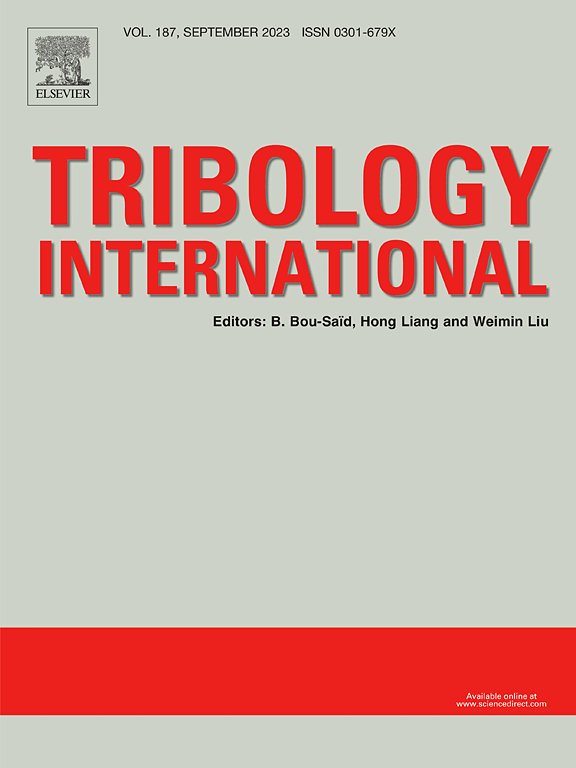深海环境下水润滑橡胶轴承热粘超弹性混合流体动力润滑性能研究
IF 6.1
1区 工程技术
Q1 ENGINEERING, MECHANICAL
引用次数: 0
摘要
深海环境的特点是高压和低温条件,对深海设备的运行提出了重大挑战。为了研究深海环境下水润滑橡胶轴承(WLRBs)的热粘超弹性混合润滑性能,建立了水润滑橡胶轴承热粘超弹性混合流体动力润滑模型(mtvhhm)。该模型结合了深海高压和低温条件以及轴承内部局部温度升高对橡胶材料性能的影响。在本研究中,通过已发表的实验结果验证了该模型预测的中心流体压力分布和温度分布,从而证实了其准确性。此外,在目前的模拟条件下,随着比压的增加,海水深度对WLRBs热粘超弹性混合润滑性能的影响更加明显。随着海水深度的增加,海水压力的升高降低了流体剪应力。然而,这种影响被环境温度的降低部分抵消。因此,流体剪切引起的摩擦系数和热通量随海水深度的增加变化相对较小。随着海水深度的增加,粘弹性耗散和实际接触剪切的变化是影响总摩擦系数和热通量的主要因素。此外,在较深的海水环境中,WLRBs可以在相对较低的速度下实现类似于弹流动力润滑的状态。该研究为WLRBs在深海环境中的应用提供了有价值的参考。本文章由计算机程序翻译,如有差异,请以英文原文为准。
Study on mixed thermal-visco-hyerelastic hydrodynamic lubrication performance of water-lubricated rubber bearings in deep-sea environment
The deep-sea environment is characterized by high-pressure and low-temperature conditions, presenting significant challenges for equipment operating in deep-sea. To investigate the mixed thermal-visco-hyperelastic lubrication performance of water-lubricated rubber bearings (WLRBs) in deep-sea environment, this paper develops a mixed thermal-visco-hyperelastic hydrodynamic lubrication model (MTVHHLM). This model incorporates the effects of both the deep-sea high-pressure and low-temperature conditions, as well as localized temperature increases within the bearing, on the rubber material properties. In this study, the central fluid pressure distribution and temperature distribution predicted by the present model are validated by published experimental results, thereby confirming their accuracy. Furthermore, under the current simulation conditions, as specific pressure increases, the influence of seawater depth on the mixed thermal-visco-hyperelastic lubrication performance of WLRBs becomes more pronounced. As seawater depth increases, the rise in seawater pressure reduces fluid shear stress. However, this effect is partially offset by the decrease in ambient temperature. Consequently, the variations in friction coefficient and heat-flux caused by fluid shear with increasing seawater depth are relatively minor. The variation in viscoelastic dissipation and actual contact shear is the primary factor influencing the total friction coefficient and heat-flux as seawater depth increases. Furthermore, in deeper seawater environments, WLRBs can achieve a state closely resembling elastohydrodynamic lubrication at relatively low speeds. This study offers a valuable reference for the application of WLRBs in deep-sea environments.
求助全文
通过发布文献求助,成功后即可免费获取论文全文。
去求助
来源期刊

Tribology International
工程技术-工程:机械
CiteScore
10.10
自引率
16.10%
发文量
627
审稿时长
35 days
期刊介绍:
Tribology is the science of rubbing surfaces and contributes to every facet of our everyday life, from live cell friction to engine lubrication and seismology. As such tribology is truly multidisciplinary and this extraordinary breadth of scientific interest is reflected in the scope of Tribology International.
Tribology International seeks to publish original research papers of the highest scientific quality to provide an archival resource for scientists from all backgrounds. Written contributions are invited reporting experimental and modelling studies both in established areas of tribology and emerging fields. Scientific topics include the physics or chemistry of tribo-surfaces, bio-tribology, surface engineering and materials, contact mechanics, nano-tribology, lubricants and hydrodynamic lubrication.
 求助内容:
求助内容: 应助结果提醒方式:
应助结果提醒方式:


